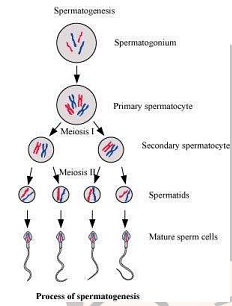What is spermatogenesis? Briefly describe the process of spermatogenesis.
Solution and Explanation
Spermatogenesis is the process of the production of sperms from the immature germ cells in males. It takes place in seminiferous tubules present inside the testes. During spermatogenesis, a diploid spermatogonium (male germ cell) increases its size to form a diploid primary spermatocyte. This diploid primary spermatocyte undergoes first meiotic division (meiosis I), which is a reductional division to form two equal haploid secondary spermatocytes. Each secondary spermatocyte then undergoes second meiotic division (meiosis II) to form two equal haploid spermatids. Hence, a diploid spermatogonium produces four haploid spermatids. These spermatids are transformed into spermatozoa (sperm) by the process called spermiogenesis.

Top Questions on Human Reproduction
- Humans are sexually reproducing and viviparous. The male reproductive system is composed of a pair of testes, the male sex accessory ducts, the accessory glands, and external genitalia. The female reproductive system consists of a pair of ovaries, a pair of oviducts, a uterus, a vagina, external genitalia, and a pair of mammary glands. The reproductive cycle of female primates is called the menstrual cycle. The menstrual cycle starts only after attaining sexual maturation (puberty). Coitus followed by fertilization leads to the formation of a zygote. After 9 months of pregnancy, the fully developed foetus is ready for delivery.
- CUET (UG) - 2024
- Biology
- Human Reproduction
- Arrange the following stages of oogenesis in order of their occurrence:
(A) Ovum
(B) Oogonia
(C) Primary oocyte
(D) Secondary oocyte
Choose the correct answer from the options given below:- CUET (UG) - 2024
- Biology
- Human Reproduction
- Sex in human embryos is determined by:
- CUET (UG) - 2024
- Biology
- Human Reproduction
- The process of transformation of spermatids into spermatozoa is known as:
- CUET (UG) - 2023
- Biology
- Human Reproduction
- Which one is not a barrier method for birth control ?
- CUET (UG) - 2023
- Biology
- Human Reproduction
Questions Asked in CBSE CLASS XII exam
- Find the inverse of each of the matrices,if it exists \(\begin{bmatrix} 2 & 1 \\ 7 & 4 \end{bmatrix}\)
- For what values of x,\(\begin{bmatrix} 1 & 2 & 1 \end{bmatrix}\)\(\begin{bmatrix} 1 & 2 & 0\\ 2 & 0 & 1 \\1&0&2 \end{bmatrix}\)\(\begin{bmatrix} 0 \\2\\x\end{bmatrix}\)=O?
What is the Planning Process?
- CBSE CLASS XII - 2023
- Planning process steps
- Find the inverse of each of the matrices,if it exists. \(\begin{bmatrix} 2 & 3\\ 5 & 7 \end{bmatrix}\)
- Find the inverse of each of the matrices, if it exists. \(\begin{bmatrix} 1 & 3\\ 2 & 7\end{bmatrix}\)
Concepts Used:
Gametogenesis
The gametogenesis process includes the formation of reproductive cells or sex cells in living organisms. In plants, it is carried throughout mitosis whereas, in animals, it is carried through meiosis. The formation of male and female gametes are the two basic steps that take place during the gametogenesis process.
Based on the living organism, the process of gametogenesis occurs in:-
Plants: It occurs by the meiotic division of diploid gametocytes. In higher plants, it happens along with sporogenesis.
Animals: It occurs by meiosis where gametes are formed from their diploid mother cells exist in organs called gonads.
Stages of Gametogenesis
The gametogenesis process occurs in three steps. They are as follows;
- Mitotic divisions together with cell growth of precursor germ cells.
- The happening of Meiosis I and Meiosis II for producing haploid daughter cells.
- Metamorphose haploid daughter cells for the production of functional gametes.



